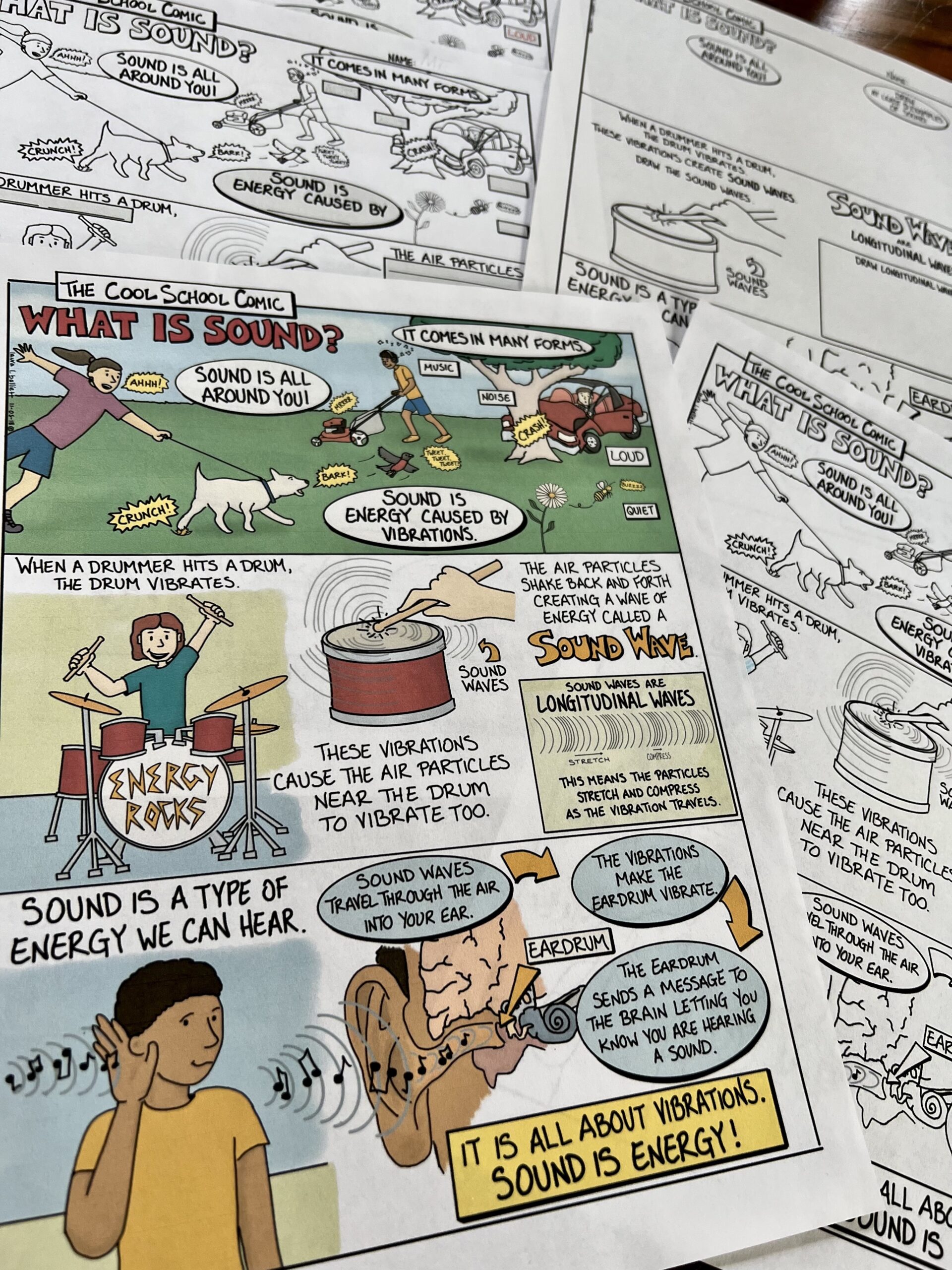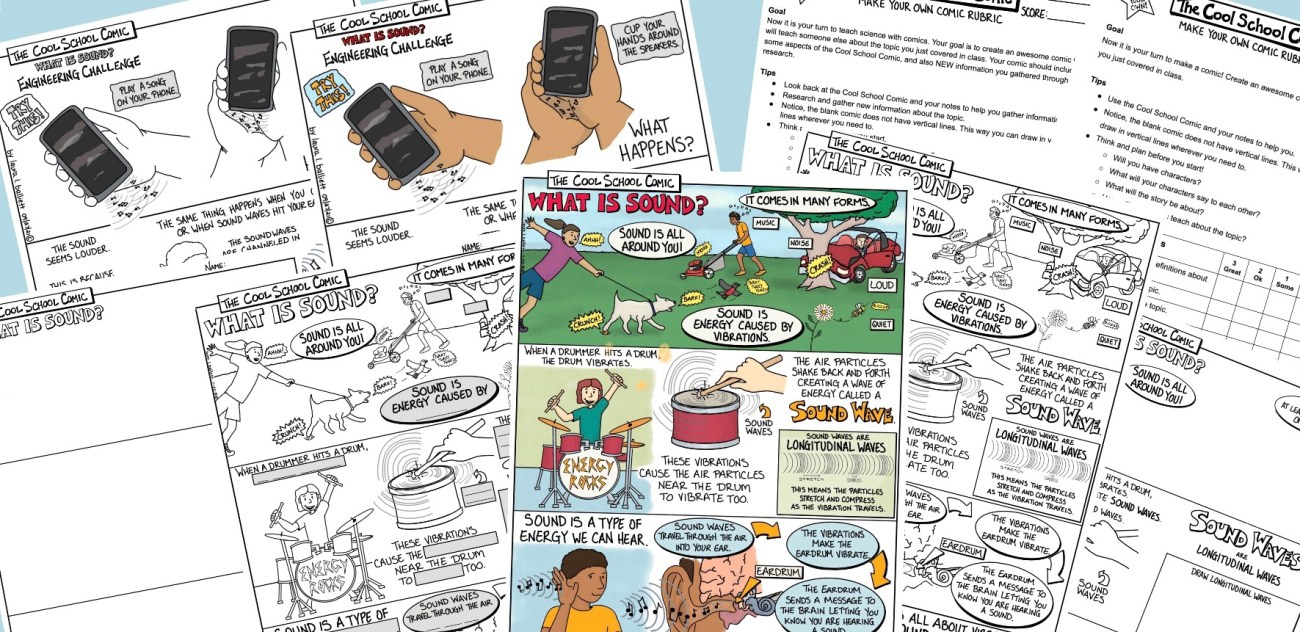Blog
Vibration, Sound Waves, and STEM Project

Solidify Understanding of Vibrations, Sound Waves, and Energy with This Relatable STEM Challenge
Low-prep and low-cost, this science project will have your middle school students engulfed in inventing and applying what they know.
Learn how to bring this memorable sound waves lesson into your classroom and witness the excitement.
Project: STEM Smartphone Speakers
Let’s start with the best part of this sound waves lesson plan: the STEM challenge.
A favorite in all of my STEM classes, this science project aligns with the vibration, sound, and sound waves unit. It incorporates creative thinking, problem-solving, inventiveness, and fun.
My middle school STEM students would gasp excitedly whenever I introduced this project. After all, it meant they were allowed to use their cell phones in class.
For this science project, students are challenged to harness the sound waves coming out of their phones and channel them into homemade speakers. They are allowed to use a range of recyclables, but nothing electronic. This requires inventiveness and creativity.
Visual Instructions
My middle school students are notorious for not reading directions. It does not matter how fun the STEM activity may be. Reading directions always seems to be a chore.
These instructions present a brief review of the concept and prompt the students to apply their understanding and get inventive.
The Complete Sound Waves Lesson Plan
A favorite in all of my STEM classes, this project aligns with the vibration, sound, and sound waves unit. It incorporates creative thinking, problem-solving, inventiveness, and fun. My middle school STEM students would gasp excitedly whenever I introduced this project. After all, it meant they were allowed to use their cell phones in class.

Sound Waves Slideshow
This fully animated Google slideshow breaks up the comic into different slides. Students will learn about waves, vibration, sound energy, and more.
I use this slideshow while I am introducing the topic, before handing out the science cartoon. The slideshow will be your own copy enabling you to share and edit it.

The Science Cartoon
The “What is Sound? Waves Comic” aligns with NGSS standards and breaks the content into manageable chunks. When information is presented in this visual format, it sticks.
I always use this science comic as a follow-up to the slideshow. When I have given it to my students before the slideshow, they jump ahead too much.

Vibration, Sound Supplementals
From Doodle Notes to guided notes, there are multiple opportunities to reinforce understanding before the big hands-on STEM project.
I tend to send the guided notes out with the science cartoon, and I ask students to use them as guided reading. There have been times when I have students use them as guided notes while I teach.
The STEM Project
Ignite Curiosity
I always start middle school STEM projects like this with a quick Google search and demonstrate this process by projecting it on the front board. Simply search a few keywords, such as “homemade smartphone speakers.” Students get to see other designs and begin to determine a plan of action. This works as a great visual aid and engagement tool.
Constraints
The next step is to explain the design constraints and for students to start planning their designs. My students are required to write as many ideas as they can down. For sound waves, they are expected to include them in their sketches.
Quite often, when I circle the room monitoring the progress of the groups, there is always a lot of talk about vibration, sound, and how to increase the volume. They get into it.
Design Approval
I always require my classes to go through the design approval process. Too many students scribble down something with the hopes of skipping the planning phase and jumping right into building.
Building is fun, but middle school students need to learn how to take their time and form a solid plan of action.


The Fun Part: Building Cell Phone Speakers
Once designs are completed and approved, it is time for the fun to begin. Students eagerly dive into the activity. My classroom is always a-buzz with the sound of kids on-task and enjoying the learning experience. This is when learning truly occurs.

What is Sound? Vibration and Energy
When it comes to sound, vibration and energy are key concepts to focus on. Be it a dolphin sound or a tornado siren, sound is a type of energy that travels through the air in the form of waves. These waves are created when an object vibrates or moves back and forth quickly. The vibrations create pressure changes in the air, which then travel through the air as sound waves.
For example, when someone speaks, their vocal cords vibrate, creating pressure changes in the air. These pressure changes travel through the air as sound waves. The same thing occurs with animals like sheep, a dog, or a goat. Sound waves are created when they cause pressure changes in the air. The waves reach our ears and our eardrums vibrate in response, allowing us to hear the sound.
Sound can also travel through other materials, such as water and solid objects, but it travels more quickly and efficiently through the air. Different sounds can also have different properties, such as pitch (high or low) and loudness (soft or loud).
It’s a fundamental concept of Physics and it’s very important for children to understand the basic principles of sound to help them understand the surrounding world better. Vibration, sound, and energy are all tied together.
More Sound Project Ideas
There are many STEM projects that involve the study of sound waves. Here are a few examples:
- Build a simple sound wave generator: Students can create a simple sound wave generator by attaching a metal rod to an oscillator circuit. The circuit can be adjusted to create different frequencies of sound waves, which students can observe and measure using a microphone and oscilloscope.
- Musical Instrument Project: STEM students love this project! The task is to design and build a musical instrument, such as a guitar or xylophone, that utilizes sound waves. They can experiment with different materials and designs to see how they affect the sound produced by the instrument.
- Study the properties of sound waves: Students can experiment with different sound sources, such as tuning forks or speakers, and measure the properties of the sound waves they produce. They can use a microphone and oscilloscope to measure the frequency, amplitude, and wavelength of the sound waves.
- Soundproofing materials: Students can conduct experiments to evaluate the sound-absorbing properties of different materials, such as foam, fiberglass, and mineral wool, and compare them with each other. They can also explore different design options to construct a soundproofing device.
- Study of sound waves in liquids: Students can conduct experiments to observe the behavior of sound waves in different liquids and compare them with air. They can also try to measure the speed of sound in liquids.
- These are just a few examples, but there are many other possibilities for STEM projects related to sound waves. The key is to provide students with an opportunity to engage in hands-on learning and explore the concepts in a real-world context.
It Sounds Like this Might be the End
Sound, vibration, and energy are all concepts that can be taught through hands-on learning. There is no need for a traditional lecture. The incorporation of these comic packages melds a lesson plan template, clip art, and active learning. All of my projects are low-prep, low-cost, and creativity-based.
Sign up for the Cool School Comic newsletter for updates and FREE comics!

